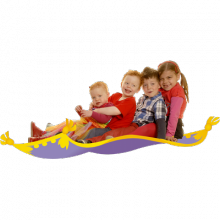Well recorded quality songs for children are as important as good books. Because well written children's songs that are also well recorded, offer rich experiences to the mind and soul.
Peter Combe's children's songs use an extensive range of musical styles. They are written in a way that is very attractive to children, and cover subjects understood by children, including the 3 R's, Christmas, Australian themes, the environment, animals, nature, health and fitness, fairy tales and absurd situations.
The children's music created by Peter are ideal songs for teaching, and make useful music teacher and education resources. Here are some of the reasons why…
The value of children’s music
Good children’s songs are a precious educational resource. A song has twice the potential to impact as it contains both melody and lyrics. A good kids song can:
- encourage a love of singing
- help develop reading skills
- introduce poetic rhyme in a fun way
- teach a sense of rhythm
- incorporate movement with music
- be rich and beautiful – create a sense of awe
- introduce children to the sound of real instruments
- inspire children to learn an instrument
- be timeless – and like folk music be handed down to the next generation
- become a common language that can bring children together in a joyous singalong
- integrate in to other curriculum areas e.g. drama classes, physical education (phys ed or PE)
- specific songs can be used to reinforce concepts in maths, science, history etc
- a good song is a combination of music and poetry
Why are songs a valuable part of a child’s education?
When it comes to education it is generally accepted that literacy is the essential ingredient. The ability to read and write is one of life’s most valuable skills. Often educators relegate music to an optional extra in the curriculum. Most parents who wish their child to have a musical education need to employ private tutors and enrol them in out of school musical activities.
Most people easily see the value in a good book, with an engaging story accompanied by engaging pictures. But consider a good song. It is an engaging poem accompanied by an engaging melody, and if on CD, with the added bonus of an arrangement of musical instruments and a voice.
But it is often the artistic content – the illustrations or the power of the music that draws the child in and keeps them interested.
Music is absorbed by the right hand creative side of the brain, compared with the reading of the printed word which uses the left side to process the letters and decipher them.
Listening to the words of a well constructed poem set to music, or a good illustrated story read by a parent, fosters in the child a love of language. And a well constructed melody fosters a love of music.
Songs can inspire different moods – funny, quirky, uplifting, sad, joyous
A simple rhythmic song makes you want to move. Its fun to move to music and much more can be achieved with a musical background - health and fitness, development of coordination. Movement with music appeals to a child’s natural vitality.
Children's songs can also provide information – for example Big Yellow Ball, I have, Tadpole Blues, Hadrian’s Wall, 12345.
Songs and music are an effective teaching tool for children by packaging information in an engaging concise format. They can be used as tool to introduce a concept or stimulate discussion or enquiry.
What makes a good kids song?
A good children’s song is as challenging and rewarding to write as a good adult’s song. A good song has:
- an original concept, relevant to the child
- lyrics that can be funny and appeal to kids' sense of humour
- can be poignant and describe sad feelings, or be uplifting, joyous and celebrational
- lyrics that are carefully crafted, like a good poem
- innovative rhymes
- a melody that can be simple, singable and fun, or beautiful, heart rending and inspiring
- one of many different styles the ability to pass the “goosebumps” test

